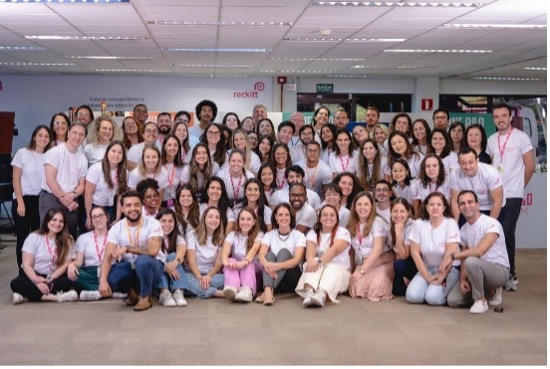Charting a path forward for women in science
The International Day of Women and Girls in Science is a fantastic opportunity to celebrate women in science, technology, engineering and mathematics (STEM) and our inclusive approach at Reckitt.
Despite women representing half of the global population, less than a third of researchers globally are women[1]. While there is great progress being made in the medical and microbiology fields, there is still work to be done in other areas—such as data science, physics, chemistry, engineering and advanced mathematics.
Studies have also shown disparities in academic publishing, with fewer women as authors in scientific journals compared to their male counterparts[2]. That’s why the diversity of thought is ingrained into our culture when it comes to science at Reckitt.
We caught up with Angela Naef, Chief Research and Development (R&D) Officer at Reckitt, to understand what role we can all play in empowering women and girls to pursue a career in STEM.

Where did your STEM journey begin?
My fascination with science started with a little red microscope. It was given to me as a gift by my parents. I used to take it everywhere with me—to school, to friend’s houses and the park. I used to collect leaves, stones even insects! Whatever I could hunter-gather. Every time I used it to look at the intricate details of life through another lens, it made me even more curious.
Who inspired you?
My mom was a key role model in my early years. She went to nursing college while raising my sisters and me. One day she brought back a big hardback book as part of her studies—all about microbiology. I took that book and kept it in my room. Every night I used to open that book and look at the pictures of micro-organisms and imagine what else I could put under my little red microscope.
How can we inspire young girls to follow a STEM path?

I appreciate that not all families or backgrounds are created equal. I’ve experienced this first-hand with the young people I meet at various STEM events and Science Symposiums. While it can vary across geographies and cultures, one thing that continues to amaze me when I attend these events is how little girls know what science can achieve. Being a role model for others is important. It’s important to be visible. It’s important to show the different types of careers available, with STEM as a foundation. I see it as my job, and the job of women in my team, wherever we are in the world, to inspire and make science a really awesome place to be for young people, whatever their background.
Why are women important in scientific research?

At the heart of it, the involvement of women in our scientific research is not just about achieving gender parity; it’s about recognising the unique perspectives they bring to the table.
This couldn’t be more true when looking through the lens of women’s health. At Reckitt, we develop solutions for categories that have a bias towards women. It’s therefore important to mirror our expertise with the categories we play in. For example, we have discovered that there are intricate differences in how women experience pain, understand sexual health and suffer from gastrointestinal conditions. We know that women experience pain differently from men—migraines affect three times as many women as men[3]. From a gastrointestinal perspective, irritable bowel syndrome is more common in women than men—on an almost two-to-one ratio[4]. When it comes to intimate wellness there is also a huge amount of education to be done across different life stages for women. In 2023, we published the first clinical study which proved a wider set of health benefits and importance of lubricants in sexual health for women of all ages[5]. Our findings also challenged the current beliefs that lubricants disrupt the vaginal microbiome and are for women pre and post-menopause. If we can utilise science and make it more accessible to break the silence on taboo subjects for women, I believe we can have a profound impact on global health.
What are your top tips for being an ally to women in science?
I firmly believe in allyship, and it’s the one thing that can have a profound impact on ensuring equitable opportunities for women in science. Allyship is many things. It involves actively listening, learning, being supportive and inclusive by standing in solidarity with others.
For me, the greatest gift in allyship has been time. When I was a graduate and looking for my first year in industry I met a former student from my graduate group who helped me with landing my first job. His name was Paul. He helped me land my first job as a researcher at my first company. Paul was a true ally. Time to talk about the day I’d had or the challenges I was facing. Time to listen and understand.
To change the paradigm we need to be ‘more Paul’. We need to create an inclusive environment that simply gives time. Time to listen. Time to understand. Time to inspire. Time to role-model. Whether it’s mentorship, sponsorship or simply amplifying voices, allies play a pivotal part in charting the way for young girls and women to ascend the scientific ladder.
Stronger together
The journey toward gender equity in science is a collective effort. Allyship is not a passive stance; it’s an ongoing commitment to creating an inclusive and equitable landscape. Let’s pledge to be allies, advocating for, supporting and championing women in science, thereby ensuring that talent knows no boundaries and innovation knows no limits.
Let’s step forward, together, and make a difference.
[1] Women in Science | UNESCO UIS
[2] Female is Not First: the Gender Gap in Publishing Means More Needs to be Done | Pharmaceutical Research (springer.com)
[3] Gender-related differences in migraine - PMC (nih.gov)
[4] Kim, Y. S., & Kim, N. (2018). Sex-gender differences in irritable bowel syndrome. Journal of neurogastroenterology and motility, 24(4), 544
[5] https://academic.oup.com/jsm/article/20/4/498/7035572